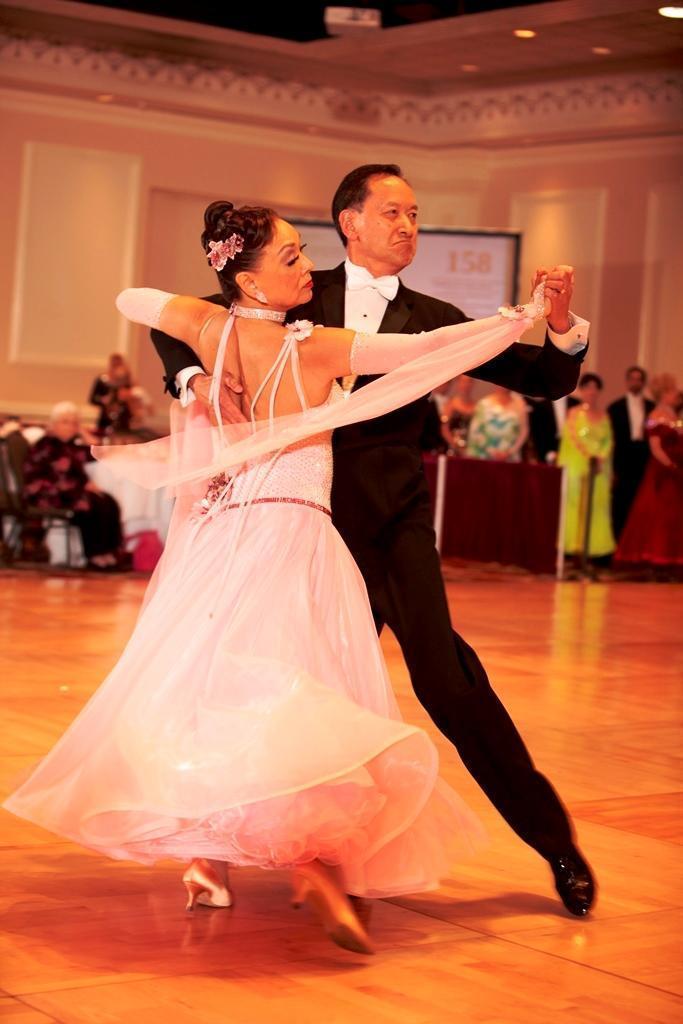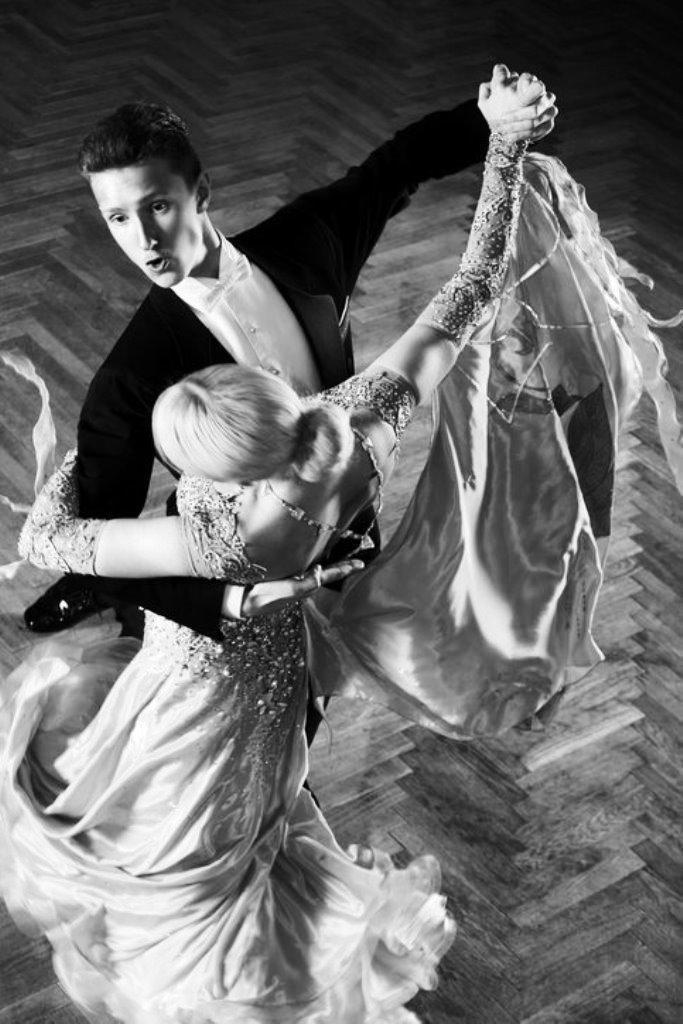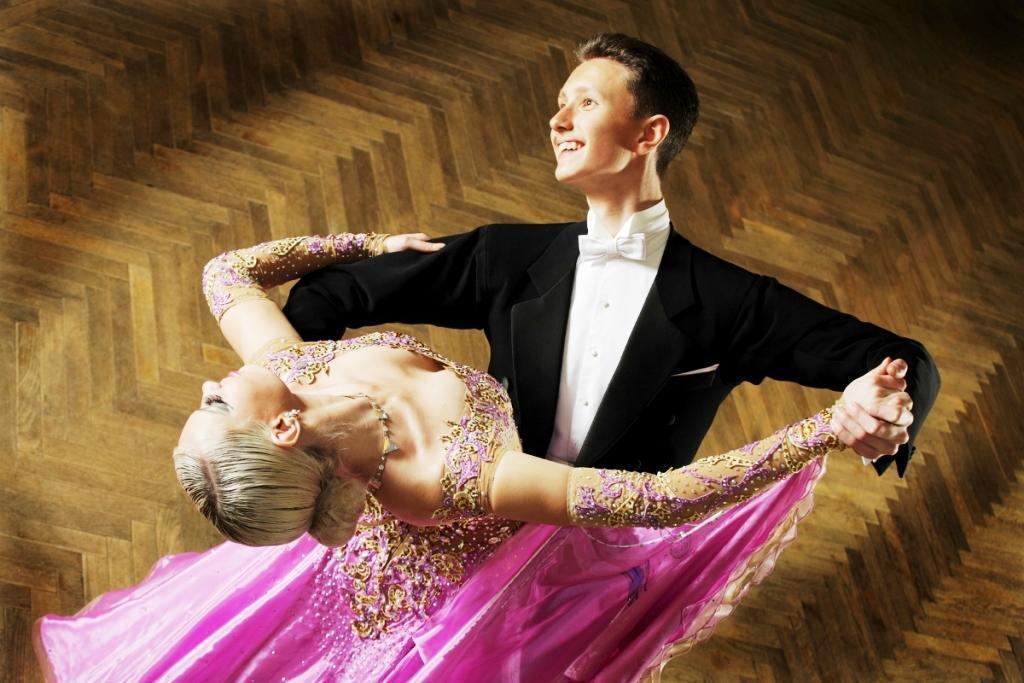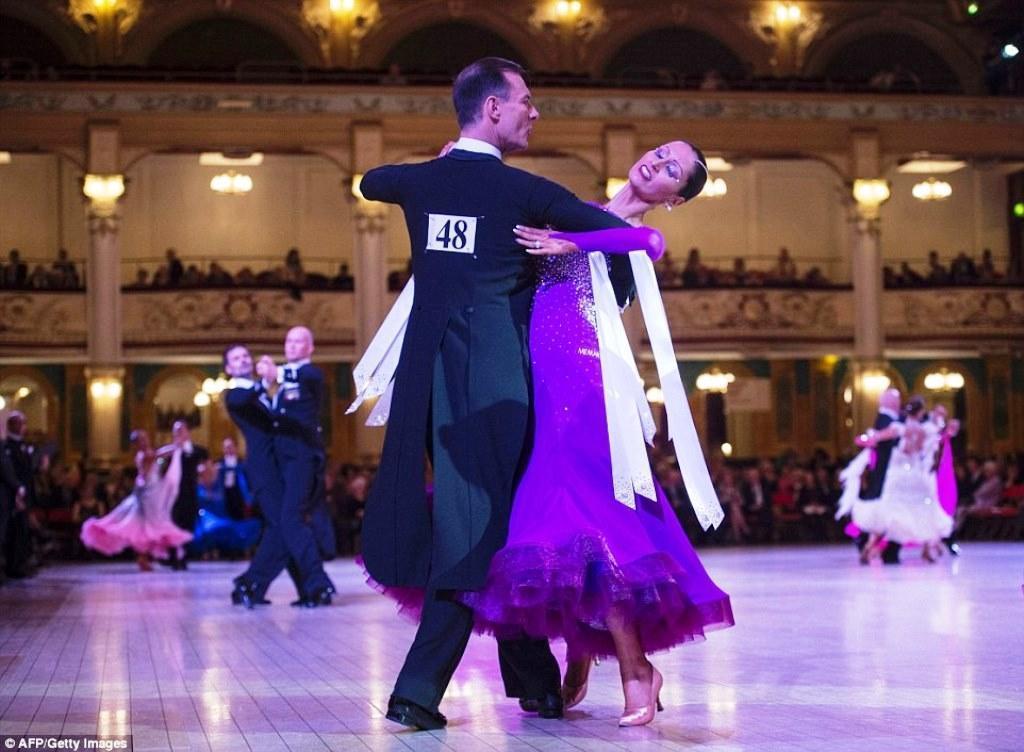
1. Waltz
Waltz
The waltz is one of the oldest and most popular ballroom dances in Britain. It originated in the early 19th century in Vienna, Austria and has since become a staple of the British ballroom dance scene. The waltz is characterized by its graceful, sweeping movements and is danced in 3/4 time.
The waltz is a very social dance and is often used as an introduction to ballroom dancing. It is suitable for all ages and abilities and is a great way for beginners to learn the basics of ballroom dancing.
The waltz is danced in a closed position, with the couple’s arms around each other and their bodies in contact. It is usually danced in a counter-clockwise direction, with the man leading and the woman following. The waltz is usually danced to slow, romantic music.
Types of Waltz
There are several different types of waltz, including the Viennese Waltz, the Slow Waltz, the Quickstep, and the Foxtrot. The Viennese Waltz is the original form of the waltz and is usually danced to fast-paced music. The Slow Waltz is a more modern version of the waltz and is usually danced to slower music. The Quickstep is a faster version of the waltz and is usually danced to upbeat music. The Foxtrot is a combination of the waltz and the foxtrot and is usually danced to medium-tempo music.
2. Foxtrot
Foxtrot
The Foxtrot is a smooth, progressive dance that originated in the United States in the early 20th century. It was created by vaudeville actor Harry Fox, who was known for his comedic dance routines. The dance was popularized in the UK in the 1920s, and it quickly became a fixture in British ballroom culture.
The Foxtrot is characterized by its walking steps and side-by-side movements. It is considered a “smooth” dance, meaning that the couple moves in a continuous, flowing motion. It is danced in 4/4 time, and the music usually has a moderate tempo.
Variations of the Foxtrot
There are several variations of the Foxtrot, including the Quickstep, Slow Foxtrot, and the Waltz Foxtrot. Each variation has its own unique set of steps and movements.
The Quickstep is a faster version of the Foxtrot, and it is usually danced to more upbeat music. It is a more challenging dance, and it requires more precise timing and footwork.
The Slow Foxtrot is a slower version of the Foxtrot, and it is usually danced to music with a slower tempo. It is a more romantic version of the Foxtrot, and it is often considered the more “elegant” version of the dance.
The Waltz Foxtrot is a combination of the Waltz and the Foxtrot. It is a slower version of the Foxtrot, and it is usually danced to music with a slower tempo. It is a more romantic version of the Foxtrot, and it combines elements of both the Waltz and the Foxtrot.
Popularity of the Foxtrot in the UK
The Foxtrot is one of the most popular dances in the UK. It is a popular choice for weddings, and it is often performed at other special events and occasions. The Foxtrot is a timeless classic that is sure to remain a fixture in British ballroom culture for years to come.
3. Quickstep
3. Quickstep
The Quickstep is a fast-paced, lively dance that originated in the 1920s. It is a combination of the Foxtrot and the Charleston, and is one of the most popular dances in the UK. The Quickstep is characterised by its quick, energetic steps, and is often danced to upbeat music.
The Quickstep is also known for its intricate patterns and footwork. It consists of a series of quick steps and slow steps, which are often combined with hops, runs, and chasses. The Quickstep is a great dance for those who want to show off their fancy footwork.
History of the Quickstep
The Quickstep is believed to have originated in the 1920s, when it was first seen in London ballrooms. It was created by combining the Foxtrot and the Charleston, and quickly became popular in the UK.
The Quickstep was further developed in the 1930s, when it was adapted for the smaller dance floors of the time. The steps were made smaller and faster, and the dance was given its distinctive quick-step rhythm.
The Quickstep has since become a popular dance in the UK, and is seen in many competitions and social events. It is a great dance for those who want to show off their fancy footwork.
4. Cha-Cha-Cha
4. Cha-Cha-Cha
The Cha-Cha-Cha is a lively and fun dance that originated in Cuba in the 1950s. It is a partner dance that follows a 4/4 rhythm and is danced to a variety of Latin music. The Cha-Cha-Cha is a popular dance in the UK and is often seen at dances and competitions.
The Cha-Cha-Cha is a fun and energetic dance that is suitable for all ages and abilities. The steps involve quick and sharp movements and can be adapted to suit different levels. It is a great way to get active and have fun with your partner.
The History of the Cha-Cha-Cha
The Cha-Cha-Cha was created by Cuban violinist Enrique Jorrin in the 1950s. He blended elements of the Mambo and Rumba to create the Cha-Cha-Cha. The dance quickly spread throughout the world and became popular in the UK in the 1970s.
Cha-Cha-Cha in the UK
The Cha-Cha-Cha is a popular dance for competitions and social events in the UK. It is a fun and energetic dance that is suitable for all levels. There are a variety of competitions and classes available for those who want to learn the Cha-Cha-Cha.
The Cha-Cha-Cha is a great way to have fun and get active. It is a popular dance in the UK and is sure to be a hit at any event.
5. Rumba
Rumba
The Rumba is a Latin American dance that has become popular in the UK. It is a passionate and sensual dance that combines elements of Cuban, Spanish, and African dance.
The Rumba is believed to have originated in Cuba in the late 19th century. It was originally a courtship dance between a man and a woman, with each partner trying to impress the other with their movements. As the dance became popular, it spread to other parts of Latin America and eventually to Europe.
The Rumba is performed in a 4/4 time signature and is usually danced to slower tempo music. It is characterized by a slow, sensuous movement of the hips and a lot of body contact between partners.
Styles of Rumba
There are two main styles of Rumba that are popular in the UK: the Cuban Rumba and the International Rumba. The Cuban Rumba is a more authentic version of the dance, while the International Rumba is a simplified version that is easier to learn.
The Cuban Rumba is characterized by sharp, fast movements and a lot of improvisation. It is usually danced in a circle or in a line formation. The International Rumba is more structured and is usually danced in a closed position.
Popularity in the UK
The Rumba has become increasingly popular in the UK in recent years. It is a popular choice for social dances and competitions, and it is often used as a show dance. The Rumba is a great way to show off your skills and express your passion for dance.
6. Jive
6. Jive
Jive is a lively and energetic dance style that was popularised in Britain during the late 1940s and early 1950s. It is a form of swing dance that developed from the Lindy Hop, which originated in the United States. The dance is characterised by its fast-paced, energetic movement and its distinctive footwork.
Jive is a great way to get your heart racing and have some fun with friends. It is often danced to fast-paced rock and roll music, and it is a popular choice for both social and competitive dancers.
History of Jive in the UK
Jive was first introduced to Britain in the late 1940s by American servicemen stationed in the UK. The dance quickly became popular and spread across the country as more and more people began to learn it.
By the early 1950s, jive was a popular dance style in Britain, with many clubs and dance halls hosting jive nights. The popularity of jive in the UK was further boosted by the release of the film ‘Rock Around the Clock’ in 1955, which featured jive dancing.
Modern Jive in the UK
Today, jive is still a popular dance style in the UK, with many social and competitive dancers enjoying the energetic and lively movements. There are many clubs and classes dedicated to teaching jive, and it is a popular choice for both social and competitive dancers.
7. Paso Doble
7. Paso Doble
Paso Doble is a traditional Spanish dance that has been popular in the UK for many years. It is a lively and passionate dance that is often performed to Spanish-style music, such as flamenco or bullfighting music. The dance is made up of two parts, the Paso Doble itself and the finale.
The Paso Doble is a dance of passion, with the man leading the woman in a series of steps and turns. The man is expected to be assertive and the woman is expected to be graceful and elegant. The finale is a dramatic ending where the man and woman come together in a passionate embrace.
History of Paso Doble
Paso Doble originated in Spain in the early 1900s. It was originally a folk dance, but it was soon adopted by the upper classes, who began performing it in ballrooms. It quickly became popular in the UK and other parts of Europe.
The dance was first introduced to the UK in the 1920s, when a group of Spanish dancers performed it at a London theatre. It quickly became popular and was soon adopted by the British ballroom dancing scene.
Today, Paso Doble is a popular dance in the UK, with competitions held all over the country. It is also a popular choice for wedding dances, as it is a passionate and romantic dance.
8. Viennese Waltz
The Viennese Waltz is a traditional ballroom dance that originated in Austria and is popular in the UK. It is characterised by its fast tempo and rotational movements. It is danced in 3/4 time and is usually performed to waltz music.
The Viennese Waltz first became popular in the UK in the mid-19th century. It was introduced to the UK by visiting musicians from Vienna and was soon adopted by the British aristocracy. Its popularity grew steadily and by the end of the 19th century, it was a staple of ballroom dancing in the UK.
The Viennese Waltz is one of the most popular ballroom dances in the UK, and is performed at social events, competitions, and in theatrical performances. It is a dance that requires skill and grace, and is a great way to show off your dancing skills.
Variations of the Viennese Waltz
The Viennese Waltz can be danced in a variety of ways. Some of the most popular variations include the Slow Waltz, the Quickstep, the Viennese Foxtrot, the Cross-Step Waltz, and the Viennese Polka. Each of these variations has its own unique style and is a great way to add some variety to your ballroom dancing repertoire.
9. Swing
9. Swing
Swing is a style of dance that originated in the United States in the 1920s and 1930s. It is a fast-paced, energetic form of partner dancing that is known for its lively and fun moves. In the UK, swing dance is generally split into two main styles: West Coast Swing and East Coast Swing.
West Coast Swing is a smooth, slotted style of swing that is danced in a slot, or line, down the dance floor. It is characterized by its ‘slotted’ movements and slow, smooth footwork. The music used for West Coast Swing is usually slow, bluesy jazz.
East Coast Swing is a faster, more energetic style of swing. It is characterized by its fast footwork and ‘rock-step’ movements. The music used for East Coast Swing is usually upbeat swing music.
Both styles of swing are popular in the UK and can be seen at social dances, competitions, and events all over the country. Swing is a great way to meet new people and have a great time on the dance floor.
10. Tango
Tango
The Tango is a passionate dance that originated in Argentina and Uruguay. It is a very energetic and intense dance, and is one of the most popular dances in the world.
In the UK, the Tango is one of the most popular ballroom dances, and it has been danced in the country since the early 20th century. The Tango was first introduced to Britain by the Argentinean-born dancer, Carlos Gardel, who was a popular performer in London in the 1920s.
The UK has seen many different styles of Tango, including the ‘Modern Tango’, which is a more romantic and refined version of the dance. The ‘Traditional Tango’ is a more energetic and passionate style, and is often seen in Latin clubs.
Tango Music
The music of the Tango is usually a combination of Latin rhythms and melodies, with a strong emphasis on the tango rhythm. The music is usually played with a piano, guitar, and flute, and the lyrics often tell stories of love, passion, and heartache.
Tango Costumes
The costumes for the Tango usually consist of a flowing dress for the woman, and a suit for the man. The costumes are usually very elegant and sophisticated, and often feature intricate embroidery and beading.
Tango Steps
The steps of the Tango are very intricate and complex. The dance is made up of a series of steps, turns, and dips, and is usually danced in a closed embrace. The Tango is a very passionate and romantic dance, and is often seen as a symbol of love and romance.




